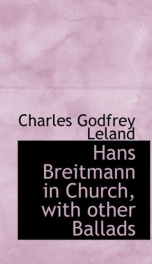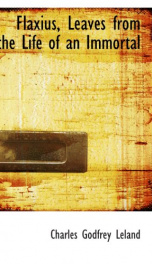Leland Charles Godfrey
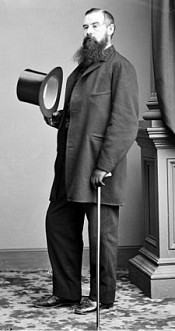
Charles Godfrey Leland (August 15, 1824 – March 20, 1903) was an American humorist and folklorist, born in Philadelphia, Pennsylvania. He was educated at Princeton University and in Europe. Leland worked in journalism, travelled extensively, and became interested in folklore and folk linguistics, publishing books and articles on American and European languages and folk traditions. By the end of his life shortly after the turn of the century, Leland had worked in a wide variety of trades, achieved recognition as the author of the comic Hans Breitmann’s Ballads,[1] fought in two conflicts, and had written what was to become a primary source text for Neopaganism half a century later, Aradia, or the Gospel of the Witches. Leland was born to Charles Leland, a commission merchant, and Charlotte Godfrey August 15, 1824 in Philadelphia, Pennsylvania. Shortly after his birth, Leland's nurse took the child to the family attic and performed a ritual on him involving a Bible, a key, a knife, lighted candles, money and salt to ensure a long life as a "scholar and a wizard", a fact which Leland's biographers have commented upon as foreshadowing his interest in folk traditions and magic.[2] Charles Godfrey Leland's early education was in the United States, and he attended college at Princeton University. During his schooling, Leland studied languages, wrote poetry, and pursued a variety of other interests, including hermeticism, Neo-Platonism, and the writings of Rabelais and Villon.[3] After college, Leland continued his studies in Heidelberg and Munich. In 1848 Leland attended the Sorbonne, and was involved in the Revolutions of 1848 in France, fighting at constructed barricades against the King's soldiers as a captain in the revolution.[4] Leland returned to America after the money given to him by his father for travel had run out, and passed the bar in Pennsylvania. Instead of practicing law, he instead began a career in journalism. As a journalist, Leland wrote for The Illustrated News in New York, the Evening Bulletin in Philadelphia and eventually took on editorial duties for Graham's Magazine, and the Philadelphia Press. In 1856 Leland married Eliza Bella "Isabel" Fisher.[4] Leland was also an editor for the Continental Monthly, a pro-Union Army publication. He enlisted in the Union Army in 1863, and fought at the Battle of Gettysburg. Leland coined the term "emancipation" as an alternative to "abolition" to refer to the anti-slavery position.[4] Leland returned to Europe in 1869, and travelled widely, eventually settling in London. In his travels, he made a study of the Gypsies, on whom he wrote more than one book. Leland began to publish a number of books on ethnography, folklore and language. His fame during his lifetime rested chiefly on his comic Hans Breitmann’s Ballads (1871), written in a combination of broken English and German (not to be confused, as it often has been, with Pennsylvania German).[5] His writings on Algonquian and gypsy culture were part of the contemporary interest in pagan and Aryan traditions. He erroneously claimed to have discovered 'the fifth Celtic tongue': the form of Cant, spoken among Irish Travellers. He named it Shelta. Leland became president of the English Gypsy-Lore Society in 1888. Eleven years later Godfrey produced Aradia, or the Gospel of the Witches, reportedly containing the traditional beliefs of Italian witchcraft as conveyed to Leland in a manuscript provided by a woman named Maddalena, who Leland refers to as his "witch informant."[6] In recent times his writings on pagan and Aryan traditions have eclipsed the now largely forgotten Breitmann ballads, influencing the development of Wicca and modern Neo-paganism. The most influential of these books is Aradia, or the Gospel of the Witches. Aradia's accuracy has been disputed,[7] and used by others as a study of witch lore in 19th century Italy.[8] Leland was also a pioneer of art and design education, becoming an important influence on the Arts and Crafts movement. In his memoirs he wrote, "The story of what is to me by far the most interesting period of my life remains to be written. This embraces an account of my labour for many years in introducing Industrial Art as a branch of education in schools[.]" He was involved in a series of books on industrial arts and crafts including a title he co-authored in 1876 with Thomas Bolas, entitled "Pyrography or burnt-wood etching," which was revised by Frank H Ball, G J Fowler in 1900. He was, more significantly, the founder and first director of the Public Industrial Art School of Philadelphia. This school is today known as Philadelphia University of the Arts. This originated as a school to teach crafts to disadvantaged children. It became became widely known when it was praised by Oscar Wilde. Wilde later wrote to Leland he would be "recognised and honoured as one of the great pioneers and leaders of the art of the future."[9] The Home Arts and Industries Association was founded in imitation of this initiative.[10]
do you like this author?
What readers are saying
What do you think? Write your own comment on this book!
write a commentWhat readers are saying
What do you think? Write your own comment on this author!
write a commentBook list

Legends of FlorenceCollected from the People,First Series
Series:
Unknown
Year:
Unknown
Raiting:
3.5/5
Show more
add to favoritesadd In favorites

The Mystic WillA Method of Developing and Strengthening the Faculties of the Mind,through the Awakened Will,by a Simple,Scientific Process Possible to Any Person of Ordinary Intelligence
Series:
Unknown
Year:
Unknown
Raiting:
3/5
Show more
add to favoritesadd In favorites
Book list

Legends of FlorenceCollected from the People,First Series
Series:
Unknown
Year:
Unknown
Raiting:
3.5/5
Show more
add to favoritesadd In favorites

The Mystic WillA Method of Developing and Strengthening the Faculties of the Mind,through the Awakened Will,by a Simple,Scientific Process Possible to Any Person of Ordinary Intelligence
Series:
Unknown
Year:
Unknown
Raiting:
3/5
Show more
add to favoritesadd In favorites
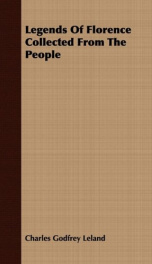
legends of florence collected from the people
Series:
Unknown
Year:
Unknown
Raiting:
4/5
Legends Of Florence Collected From The People - Charles Leland - 1895 - PREFACE - THIS book consists aImost entirely of legends or traditions of a varied character, referring to places and buildings in Florence, such as the Cathedral and Campanile, the Signoria, the Bargello, the different city gates, ancient towers and bridges, palaces, crosses, and foun tains, noted corners, odd by-ways, and many churches. To all of these there are tales, or at least anecdotes attached, which will be found as entertaining to the general reader as they will be interesting, not to say valuable, to the folk- lorist and the student of social history but here I must leave the work to speak for itseIf. I originaly intended that this should be entirely a collection of relics of ancient mythology, with supersti- tions and sorceries, witchcraft and incantations, or what may be called occult folk-lore, of which my work on Etruscan-Roman Remains in Popdar Tradition con- sists, and of which I have enough additional material to make a.............
Show more
add to favoritesadd In favorites
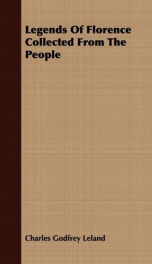
legends of florence collected from the people and
Series:
Unknown
Year:
Unknown
Raiting:
3.5/5
Show more
add to favoritesadd In favorites

fusang or the discovery of america by chinese buddhist priests in the fifth ce
Series:
Unknown
Year:
Unknown
Raiting:
3/5
Show more
add to favoritesadd In favorites
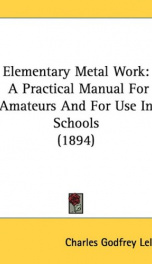
elementary metal work a practical manual for amateurs and for use in schools
Series:
Unknown
Year:
Unknown
Raiting:
3.5/5
Show more
add to favoritesadd In favorites

brand new ballads
Series:
Unknown
Year:
Unknown
Raiting:
3/5
Purchase of this book includes free trial access to www.million-books.com where you can read more than a million books for free. This is an OCR edition with typos. Excerpt from book: CARRYING COALS. In the gloomsome abysses where darkness is kept, And the spirit of silence for ages has slept, In the great shaft of Potsville, way down in the hole, There came seven parties, all dealers in coal; But they never had been in that chasm before, Nor had the sensation of darkness all o'er, Which so greatly expandeth the soul. And one of 'em said, " It's an awful delight To be infinite deep into no end of night, Where the heavenly sunshine can't manage to spring, And, talking of that, I Ve a notion, by Jing ! Let we ourselves mine out some coal lumps to-day To show to the folks,which I think, by the way, Would be a poetical thing." So they filled up their pockets, untried by a doubt, And in the hotel they unveiled 'em all out; But their glances grew strange as they turned o'er the weight, Till one of them shouted, " By thunder, it's slate !" Yet the youngest among them had dealered in coal, And unto that traffic surrendered his soul, Since the Anno Eighteen Forty-eight. For all of man's wisdom is only a dream, Which passeth away like a plate of ice-cream, And the best of experience fails, as we mark, If you go for to dig when you 're all in the dark; For there 's always a moral inside of a tale, And big things in little things always prevail As sure as there 's wood in the bark. CAREY, OF CARSON. The night-mist dim and darkling, As o'er the roads we pass, Lies in the morning sparkling As dewdrops on the grass. E'en so the deeds of darkness, Which come like midnight dews, Appear as sparkling items Next morning in the news. Away in Carson city, Far in the Silver Land, There lives one Justice Carey, A man of head and hand; And as upon his table The Judge a-smoking sat There rowdied in a rougher ...
Show more
add to favoritesadd In favorites
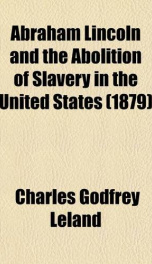
abraham lincoln and the abolition of slavery in the united states
Series:
Unknown
Year:
Unknown
Raiting:
4/5
Purchase of this book includes free trial access to www.million-books.com where you can read more than a million books for free. This is an OCR edition with typos. Excerpt from book: CHAPTER VI. A Suspncted ConspiracyLincoln's Departure for WashingtonHis Speeches at Springfield and on the road to the National Capital Breaking out of the RebellionTreachery of President Buchanan Treason in the CabinetJefferson Davis's Message'1 hreats of Massacre and Ruin to the NorthSouthern SympathisersLincoln's Inaugural AddressThe CabinetThe Days of Doubt and of Darkness. IT was unfortunate for Lincoln that he listened to the predictions of his alarmed friends. So generally did the idea prevail that an effort would be made to kill him on his way to Washington, that a few fellows of the lower class in Baltimore, headed by a barber named Ferrandina, thinking to gain a little notorietyas they actually did get some money from Southern sympathisersgave out that they intended to murder Mr. Lincoln on his journey to Washington. Immediately a number of detectives was set to work; and as everybody seemed to wish to find a plot, a plot was found, or imagined, and Lincoln was persuaded to pass privately and disguised on a special train from Harrisburg, Pennsylvania, to Washington, where he arrived February 23rd, 1861. Before leaving Springfield, he addressed his friends at the moment of parting, at the railway station, in a speech of impressive simplicity. The Springfield Speech. 89 " Friends,No one who has never been placed in a like position can understand my feelings at this hour, nor the oppressive sadness I feel at this parting. For more than a quarter of a century I have lived among you, and during all that time I have received nothing but kindness at your hands. Here I have lived from youth until now I am an old man ; here the most sacred ties of earth were assumed; here all my children were born, and here one of them lies buried. To you, dear friends, ...
Show more
add to favoritesadd In favorites
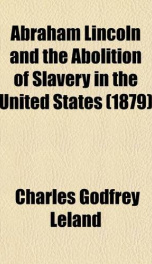
abraham lincoln
Series:
Unknown
Year:
Unknown
Raiting:
3/5
Purchase of this book includes free trial access to www.million-books.com where you can read more than a million books for free. This is an OCR edition with typos. Excerpt from book: CHAPTER VI. A Suspncted ConspiracyLincoln's Departure for WashingtonHis Speeches at Springfield and on the road to the National Capital Breaking out of the RebellionTreachery of President Buchanan Treason in the CabinetJefferson Davis's Message'1 hreats of Massacre and Ruin to the NorthSouthern SympathisersLincoln's Inaugural AddressThe CabinetThe Days of Doubt and of Darkness. IT was unfortunate for Lincoln that he listened to the predictions of his alarmed friends. So generally did the idea prevail that an effort would be made to kill him on his way to Washington, that a few fellows of the lower class in Baltimore, headed by a barber named Ferrandina, thinking to gain a little notorietyas they actually did get some money from Southern sympathisersgave out that they intended to murder Mr. Lincoln on his journey to Washington. Immediately a number of detectives was set to work; and as everybody seemed to wish to find a plot, a plot was found, or imagined, and Lincoln was persuaded to pass privately and disguised on a special train from Harrisburg, Pennsylvania, to Washington, where he arrived February 23rd, 1861. Before leaving Springfield, he addressed his friends at the moment of parting, at the railway station, in a speech of impressive simplicity. The Springfield Speech. 89 " Friends,No one who has never been placed in a like position can understand my feelings at this hour, nor the oppressive sadness I feel at this parting. For more than a quarter of a century I have lived among you, and during all that time I have received nothing but kindness at your hands. Here I have lived from youth until now I am an old man ; here the most sacred ties of earth were assumed; here all my children were born, and here one of them lies buried. To you, dear friends, ...
Show more
add to favoritesadd In favorites
What readers are saying
What do you think? Write your own comment on this author!
write a commentif you like Leland Charles Godfrey try:
readers also enjoyed
What readers are saying
What do you think? Write your own comment on this author!
write a commentGenre
if you like Leland Charles Godfrey try:
readers also enjoyed
Do you want to read a book that interests you? It’s EASY!
Create an account and send a request for reading to other users on the Webpage of the book!
